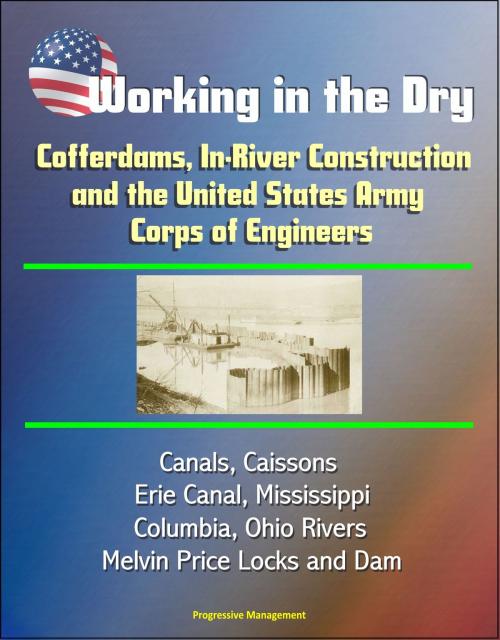Working in the Dry: Cofferdams, In-River Construction, and the United States Army Corps of Engineers - Canals, Caissons, Erie Canal, Mississippi, Columbia, Ohio Rivers, Melvin Price Locks and Dam
Nonfiction, Science & Nature, Technology, Engineering, Civil| Author: | Progressive Management | ISBN: | 9781310831232 |
| Publisher: | Progressive Management | Publication: | September 22, 2014 |
| Imprint: | Smashwords Edition | Language: | English |
| Author: | Progressive Management |
| ISBN: | 9781310831232 |
| Publisher: | Progressive Management |
| Publication: | September 22, 2014 |
| Imprint: | Smashwords Edition |
| Language: | English |
This fascinating report documents and analyzes the history of advancements in inland river construction techniques involving cofferdam and in-the-wet construction technology used by the U.S. Army Corps of Engineers. The traditional solution to this problem requires the use of a cofferdam. A cofferdam is a temporary, watertight structure erected around a construction site, designed to keep water from inundating the site during construction. Cofferdams can vary in design from simple earthen dikes heaped up around a construction site, to elaborate and costly structures constructed of steel sheet piling.
Chapter 1 - Introduction * Chapter 2 - Early American Inland Waterway Improvements * The Erie Canal * The Western Rivers * Antebellum Non-Federal Inland River Improvements * The Falls of the Ohio * Muscle Shoals * Antebellum Non-Federal Slackwater Navigation Improvements * The Monongahela Navigation Company * Chapter 3 - Early Federal In-River Construction * The Corps of Engineers and the French Engineering Tradition * The Corps' Earliest In-River Projects * Military Education and the Design of Cofferdams * The Potomac Aqueduct * Chapter 4 - Cofferdams on the Inland Rivers: The Initial Corps' Projects * Rock Island and Des Moines Rapids * Chapter 5 - Slackwater Improvement of the Ohio River * Davis Island Lock and Dam * The Canalization of the Ohio * The Ohio River Type Box Cofferdam. * Other Ohio River Innovations * Lock and Dam No 41 - Incorporation of Existing Structures into a Cofferdam * Caissons * Chapter 6 - Canalization Projects Prior to World War I * Monongahela River * Allegheny River * Kanawha River * Big Sandy River * Kentucky River * Cumberland River * Tennessee River * Hales Bar Dam * Mississippi River Headwaters * Upper White River * Big Sunflower River * Ouachita River * Mobile River System * Coosa and Alabama Rivers * Dissemination of Cofferdam Design * Chapter 7 - Introduction of Steel Sheet Pile Cofferdams * Steel Sheet Pile Design * Early Steel Sheet Pile Cofferdams * Black Rock Lock Cofferdam * Raising the Battleship Maine * Troy Lock and Dam * Cape Fear River Lock No. 2 * Chapter 8 - Adoption of Steel Sheet Pile Cofferdams * Resistance on the Upper Ohio * Ohio River Canalization: 1919-1930 * Replacement of the First Generation Ohio Dams: 1919-1937 * Deadman Island [Dashields] Locks and Dam * Montgomery Island Locks and Dam * Gallipolis Locks and Dam * The Falls of the Ohio * Steel Sheet Pile Cofferdams on Ohio Tributaries * Monongahela River * Allegheny River * Kanawha River * Persistence of Traditional Technologies: Wilson Dam on the Tennessee River * Chapter 9 - Slackwater Navigation on the Upper Mississippi * From Open River to Slackwater Navigation * Upper Mississippi 9-Foot Channel Project Cofferdams * Ohio River Type Box Cofferdams * Double-Wall Wood and Steel Cofferdam - Lock No. 6 * Single-Wall Cofferdam - Dam No. 6 * Steel Sheet Pile Cofferdams - Lock and Dam No. 26 * Continued Use of Traditional Designs - Bonneville Dam * Chapter 10 - Post World War II Cofferdam Design and Construction * The Tennessee Valley Authority's Steel Cofferdams * Design Theory for Cofferdams * Post World War II Corps of Engineers Cofferdams * The Columbia and Snake Rivers * Monongahela River * Ohio River Navigation Modernization * Chapter 11 - Contemporary In-River Construction Practice * Melvin Price Locks and Dam * Innovations in Design Methods and Behavior Analysis * Innovative Design Solutions at the End of the Twentieth Century * Point Marion Lock * In-the Wet Construction: Braddock Dam * The Work Continues: Olmsted Locks and Dam * Chapter 12 - Conclusion
This fascinating report documents and analyzes the history of advancements in inland river construction techniques involving cofferdam and in-the-wet construction technology used by the U.S. Army Corps of Engineers. The traditional solution to this problem requires the use of a cofferdam. A cofferdam is a temporary, watertight structure erected around a construction site, designed to keep water from inundating the site during construction. Cofferdams can vary in design from simple earthen dikes heaped up around a construction site, to elaborate and costly structures constructed of steel sheet piling.
Chapter 1 - Introduction * Chapter 2 - Early American Inland Waterway Improvements * The Erie Canal * The Western Rivers * Antebellum Non-Federal Inland River Improvements * The Falls of the Ohio * Muscle Shoals * Antebellum Non-Federal Slackwater Navigation Improvements * The Monongahela Navigation Company * Chapter 3 - Early Federal In-River Construction * The Corps of Engineers and the French Engineering Tradition * The Corps' Earliest In-River Projects * Military Education and the Design of Cofferdams * The Potomac Aqueduct * Chapter 4 - Cofferdams on the Inland Rivers: The Initial Corps' Projects * Rock Island and Des Moines Rapids * Chapter 5 - Slackwater Improvement of the Ohio River * Davis Island Lock and Dam * The Canalization of the Ohio * The Ohio River Type Box Cofferdam. * Other Ohio River Innovations * Lock and Dam No 41 - Incorporation of Existing Structures into a Cofferdam * Caissons * Chapter 6 - Canalization Projects Prior to World War I * Monongahela River * Allegheny River * Kanawha River * Big Sandy River * Kentucky River * Cumberland River * Tennessee River * Hales Bar Dam * Mississippi River Headwaters * Upper White River * Big Sunflower River * Ouachita River * Mobile River System * Coosa and Alabama Rivers * Dissemination of Cofferdam Design * Chapter 7 - Introduction of Steel Sheet Pile Cofferdams * Steel Sheet Pile Design * Early Steel Sheet Pile Cofferdams * Black Rock Lock Cofferdam * Raising the Battleship Maine * Troy Lock and Dam * Cape Fear River Lock No. 2 * Chapter 8 - Adoption of Steel Sheet Pile Cofferdams * Resistance on the Upper Ohio * Ohio River Canalization: 1919-1930 * Replacement of the First Generation Ohio Dams: 1919-1937 * Deadman Island [Dashields] Locks and Dam * Montgomery Island Locks and Dam * Gallipolis Locks and Dam * The Falls of the Ohio * Steel Sheet Pile Cofferdams on Ohio Tributaries * Monongahela River * Allegheny River * Kanawha River * Persistence of Traditional Technologies: Wilson Dam on the Tennessee River * Chapter 9 - Slackwater Navigation on the Upper Mississippi * From Open River to Slackwater Navigation * Upper Mississippi 9-Foot Channel Project Cofferdams * Ohio River Type Box Cofferdams * Double-Wall Wood and Steel Cofferdam - Lock No. 6 * Single-Wall Cofferdam - Dam No. 6 * Steel Sheet Pile Cofferdams - Lock and Dam No. 26 * Continued Use of Traditional Designs - Bonneville Dam * Chapter 10 - Post World War II Cofferdam Design and Construction * The Tennessee Valley Authority's Steel Cofferdams * Design Theory for Cofferdams * Post World War II Corps of Engineers Cofferdams * The Columbia and Snake Rivers * Monongahela River * Ohio River Navigation Modernization * Chapter 11 - Contemporary In-River Construction Practice * Melvin Price Locks and Dam * Innovations in Design Methods and Behavior Analysis * Innovative Design Solutions at the End of the Twentieth Century * Point Marion Lock * In-the Wet Construction: Braddock Dam * The Work Continues: Olmsted Locks and Dam * Chapter 12 - Conclusion















